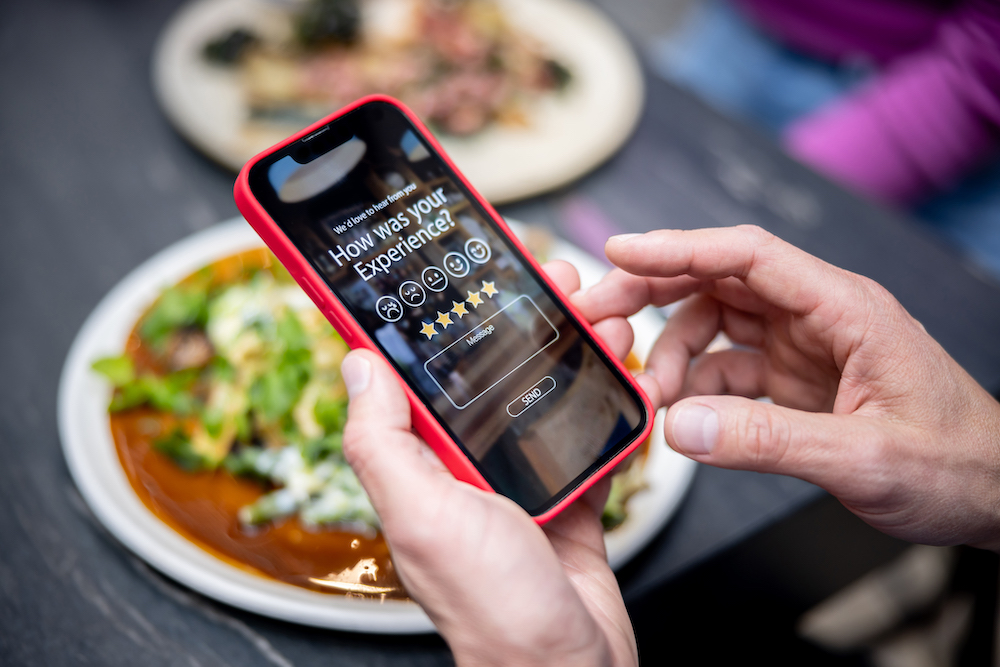By Robi Ganguly, GM, Alchemer Mobile
Alchemer recently released the 2023 Mobile Customer Engagement Benchmark Report, and Food and Drink apps enjoyed a considerable increase in app store ratings and above-average retention rates. The increase in ratings shows that mobile order-and-pay continues to gain in popularity, even as COVID regulations and protocols for the industry wind down.
The report compiles data from more than 1.2 billion app installs from Alchemer Mobile customers and the consumers who use their apps. As it does every year, the report provides unique insights into mobile customer behavior and what gets people to act. We break our analysis into three main categories: Ratings, Retention and Consumer Sentiment.
Ratings
Ratings are scores from one to five stars that may or may not include a review (a text comment). The opportunity cost of a star is huge. Jumping from two stars to three can result in a 400% increase in views and downloads. Moving from three to four stars can lead to an 89% increase in the number of people viewing and downloading an app. Food and Drink apps scored an average of 4.72 stars (4.79 for iOS and 4.51 for Android).
Related: Why pizzerias need to kick up their loyalty marketing game
Food and Drink apps saw an average of 226,114 ratings, compared to the overall average of 90,774. Similarly, Food and Drink apps earned an average of 2,920 reviews, compared to an average of 719.
Retention
The biggest challenge for Food and Drink apps is the low cost of switching, combined with the variety of alternatives. Nonetheless, the average 30-day, 90-day, and 365-day retention rates for Food and Drink apps were still above the overall average. Retention increased to 85% if consumers encountered a Love Dialog (a quick survey asking, “Do you love this app?”)
Customer Sentiment
While Food and Drink apps received a lot of feedback, Fan sentiment (Fans are those who responded “Yes” to Love Dialog prompts) was low at 54% versus 64% overall. New and Repeat fans were both at 24%, but New Risks and Repeat Risks (Risks are those who replied “No” to the question, “Do you love this app?”) came in at 22% and 15%, respectively. Those shifting from Fans to Risk and vice-versa were evenly split. New Fans/Risks are people giving their first feedback on the app. Repeat Fans/Risks are those who are repeatedly in the same camp.
Recommendations
It is particularly important for Food and Drink apps to keep pace with the market. This is especially true as new features, such as in-app ordering, become must-have features. Similarly, knowing what may not be working is essential too. Most customers now expect multiple payment options and accurate inventory reporting. Because the cost to switch to another app is low, Food and Drink apps must stay up to date with the latest trends in the industry.
The Value of Risks
Even though Risks are unhappy with an app, in the Food and Drink category, retention is just a couple of percentage points better for Fans than Risks (87% Fans versus 85% Risks after 30 days). This means that, even though they are unhappy with the app, that is not affecting their brand affiliation. It also means they’re invested in making the app work better for them. Consequently, closing the loop with these patrons not only lets them know you heard them, but when you make changes based on their feedback, they are much more likely to convert from Risks to Fans.
Related: Online ordering: Return to the Planet of the Apps
Engagement
Engagement features strongly in retention. The more mobile apps engage with their customers, the more customers will respond, especially if the communication builds on their responses to previous queries. In 2022, Alchemer Mobile customers received an average in-app survey response rate of 13%—more than two and a half times the industry average of 5% (according to Business of Apps). Even though the number of consumers prompted for in-app surveys increased to 30%, the response rate remained constant year-over-year. This shows that when brands connect with consumers for feedback, it’s often met with enthusiasm and action.
However, not all in-app surveys are delivered in the same way. The results show that when consumers are given the choice to opt in or out, response rates soar. In-app surveys that are linked to using a Note—a message or invitation from the brand—saw an average response rate of 47%. Notes and Actions are Alchemer Mobile features that allow users to take action.
Keep What You Have
Mobile app retention will remain an important metric for mobile product owners and managers, especially in this challenging economic environment. In the beginning of 2023, consumer credit card spending dropped .7% year over year, according to McKinsey. Combined with declining retention rates, consumer brands with important mobile segments are likely to shift their focus to keeping the customers they have, in addition to generating new users. Product owners and managers will likely seek out tools in 2023 to better understand why customers churn and develop programs to improve app retention.
Meanwhile, as customer emotion shifts, smart communicators will utilize messages, promotions and surveys to improve adoption and retention of their apps.
 Robi Ganguly is GM of Alchemer Mobile, a customer feedback product that can be integrated natively with mobile apps.
Robi Ganguly is GM of Alchemer Mobile, a customer feedback product that can be integrated natively with mobile apps.















